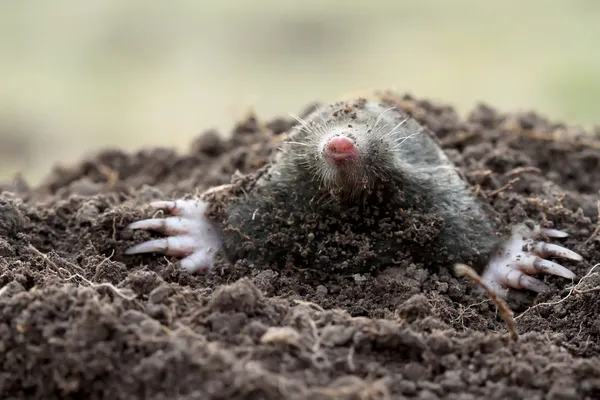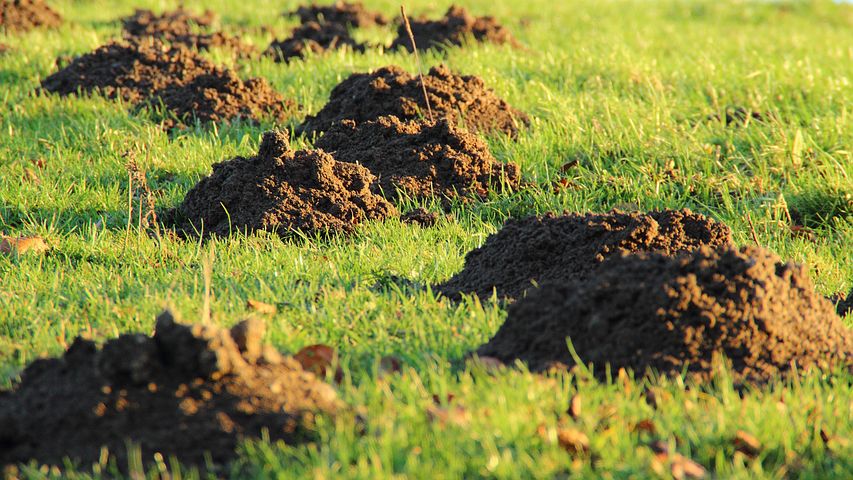MOLES
You can get sentimental about Kenneth Grahame’s classic ‘Wind in the Willows’ if you like. The mole in that book was a gentle and innocent creature, escaping the chore of spring-cleaning his tunnel home to explore the river bank with Ratty and Mr Badger. That’s a great introduction to country wildlife for children.
Anyone with a rural garden or smallholding will tell you how moles really live. Moles can tunnel up to 20 metres a day and have complex tunnel networks. You’ll see the molehills where they’ve cleared the earth from their run; maybe one at first, then two or three, then dozens. All of those hills are likely to be the work of a single creature. Moles are fiercely territorial and will fight each other to the death when they meet.
Appearance

If you’ve ever seen a mole you’ll be impressed by their work-rate. Adult moles are small, usually between 11 to 16 centimetres long with a distinct tail, all covered in a coat of short, dark fur. As their natural habitat is underground, their eyes are poorly developed and they have evolved to rely heavily on their sense of smell and hearing. They have powerful forearms and claw-tipped forepaws that are huge in comparison to their body size, designed to dig and remove earth as efficiently as a shovel.
But perhaps the most fascinating part of a mole is the nose. It is covered with bumps, each less than a tenth of a millimetre across and consisting of an extremely sensitive central nerve column that acts as a touch detector (to assess when they are touching soil that they need to clear away) with a protective fringe of pain detecting nerves that warn them of tougher or more abrasive materials.
It’s unlikely that you will ever see a live mole above ground. They are well aware that their bad eyesight leaves them vulnerable to predators such as owls, foxes and cats, and stay safely in their tunnels almost all the time. They can hear the sound of your footsteps through the earth from metres away, so if you dig into a mole-hill they will have run away long before you sink your spade into the ground.
Problems

The main problems that moles cause arises from their tunnelling. It’s said that King William III was killed when his horse stumbled over a molehill in Kensington Park and threw him out of the saddle. The tunnels themselves can collapse as livestock tread on them, leaving the animals with broken or injured legs, and drainage systems can be damaged by soil disturbance. Molehills can drastically reduce the amount of grass available to graze and their loose soil is caught up in silage, allowing for soil-borne diseases in the feed. Although moles are solely carnivorous, they reduce crop yields as they disturb roots in their hunt for earthworms.
Do It Yourself?
Best of luck if you want to control a mole problem yourself – they are persistent and wily creatures. Here are some of the ways that we’ve heard people have tried to rid their land of moles:
- Dig them out – good exercise for you, but rarely effective. Moles are sensitive to disturbance in their tunnel network and avoid areas that have been dug up.
- Use deterrents based on the mole’s aversion to noise and vibration in the soil – battery-powered hollow aluminium stakes that emit a buzzing noise below ground, or simple children’s toy windmills to stick into the soil. That tends to encourage the moles to move along to dig up a different area of your garden.
- Countryside stores sell mole traps to bury in tunnels, though the assistant may not tell you that moles can smell this human intrusion from so far away that you’re unlikely to ever catch a mole in one.
- Stick a garden hose into a tunnel and try to drown the mole inside. Waste of water and causes a horrible mess. The mole will move to a different tunnel until you’ve given up.
- The worst method I have heard of is to fire a shotgun into a molehill. Please, for your own safety, don’t. It’s far more dangerous to you than to the mole.
Call the Experts
We will assess the situation, find where the tunnel runs are and determine which method of control to use to remove moles from your land as quickly and thoroughly as possible. We’re well aware that farmers and smallholders need their land back in usable condition, and that gardeners prefer their plant roots to stay underground.
As soon as you see those tell-tale hillocks of loose soil – call us.

